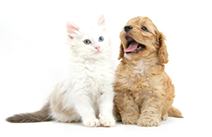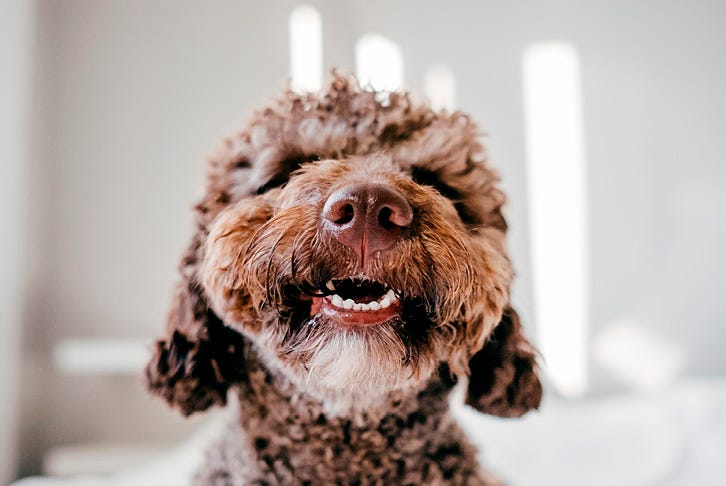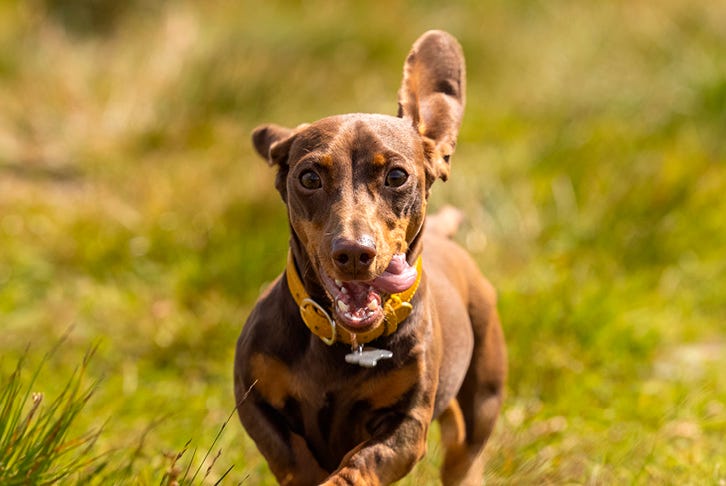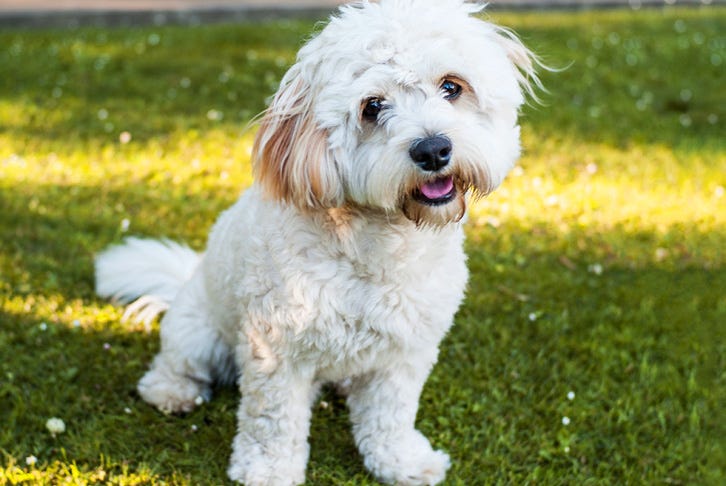How to groom a dog at home in 5 steps
Grooming isn’t just about good looks, it's also important for your canine friend's health and happiness. In addition to a daily brush and the occasional shampoo, you'll also need to think about their paws, ears and teeth.
Regularly grooming your dog at home is important to keep them healthy and smelling fresh. There are five routine grooming habits that you can do at home to help maintain your pet’s health.
Learn how to groom your dog at home by:
- Regularly brushing their coat
- Washing them
- Cleaning their ears
- Trimming their nails
- Brushing their teeth
Make this an enjoyable experience for your dog by only grooming your dog when they are in a calm and relaxed mood, and maintaining a positive tone throughout. You should introduce a regular grooming and brushing routine to your dog when they’re a young puppy so they’re accustomed to you touching and looking at various parts of their body. Grooming your dog at home also provides familiar movements in preparation for your dog to get used to being professionally groomed in an Animates Grooming salon.

Step one in grooming is brushing your dog. Brushing is important to remove loose fur, dirt and debris from your dog’s coat. This also allows your dog’s skin to breathe and stay healthy, and reduces the amount of fur that is shed on your furniture. It also helps to spread natural oils throughout your dog’s coat to increase its shine, and gives you time to bond with your pet.
How often you should brush your dog’s hair varies by breed, but it’s a great idea to brush your dog at the same time every day. You can also use this time to check your dog’s skin and coat for ticks, lumps, cuts and other skin issues.
Brush your dog’s coat in the direction that it grows and be gentle and patient with any tangles. Sensitive areas that you should focus on are their face, ears, neck ruffs, and any feathering on their legs. Brushing matted dog hair out is also important. If you notice any matted hair in your dog’s coat, try to remove them with a coat conditioner or detangler product. If you’re unable to detangle the mat, we highly recommend that you do not attempt to cut it off with scissors as you may accidentally cut your dog’s skin. Instead, have a professional groomer at an Animates Grooming Salon remove the matting from your dog’s fur.
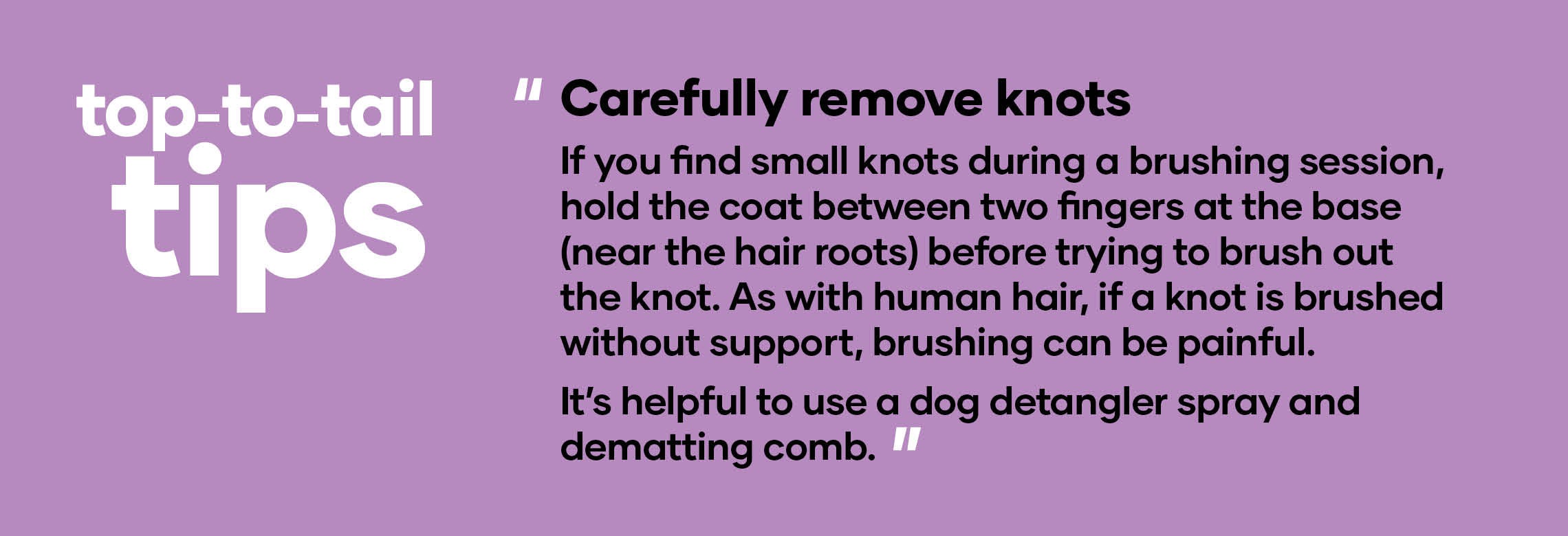
Depending on your dog’s coat type, there are a variety of dog brushes, combs, rakes and grooming gloves that will best suit their needs. Ask the friendly team members at your local Animates store which combination of grooming products will keep your dog’s coat in the optimum condition. The range includes products suitable for brushing dogs with short hair as well as long hair.

The next step is to wash and bathe your dog, although you will not have to do this every time you groom them. How often you should wash your dog will depend on factors such as their coat, environment, and activity. Ask your local Animates Vetcare team for a recommendation on how often your canine companion needs to be washed at home. As a rough guide, most dogs will not need to be washed more than once a month, though exceptions can be made for when your playful pet jumps into a puddle of mud! Don’t wash your dog more than necessary or you may risk stripping the natural oils from their coat and cause it to dry out, especially if you’re using a harsh soap-based shampoo.
Before washing your dog at home, brush through their coat to remove any tangles, and gently place cotton balls in their ears to prevent water from getting in. Where to wash your dog varies depending on your situation, but a bathroom with a tub or sink can work. Fill a tub with lukewarm water and make sure that you provide your dog with a non-slip mat to stand on. If you have a large dog that cannot fit into a tub or sink, Animates’ DIY Dog Wash units are conveniently located at our stores for a safe and mess-free way to bathe your dog.
Always use dog shampoo and conditioner and not human products, to wash your dog. Gently lather your dog with the appropriate dog shampoo, taking care to keep the shampoo out of their eyes and ears. Be sure to thoroughly rinse the shampoo from your dog’s coat as it can irritate their skin if left in. Leave in or wash out conditioner depending on what product you’re using. Finally, use a towel to help your dog dry off, and let them air dry the rest. They will want to shake, so be careful where you wash your dogs. Indoors may not be totally appropriate! You can use a hair dryer on a cool setting and low fan speed to ensure their coat is dry and fluffy.

It is possible for you to clean your dog’s ears at home but it’s best that you have a professional groomer or vet show you how to do it first. Ear cleaning is not without potential complications so an understanding on how to do it properly is important. Did you know Animates Grooming Salons offer a dog ear cleaning service that you can take advantage of?
Only specially designed dog ear cleaners should be used in your dog’s ears. Drip this solution into your pet’s ear and gently massage to help break down the wax and debris. After about 20 seconds, you can carefully and gently use a clean tissue (not cotton tip) to clean away the debris. Then, repeat this process on the other ear.
Your local Animates Vetcare team can recommend how often you’ll need to clean your dog’s ears depending on elements including their breed. Dogs with long ears with a lot of hair may require special attention when cleaning their ears.
Your dog’s ears should never smell, and any odour could be a sign of an ear infection. A possible sign that your dog’s ears are infected and will need to be assessed by an Animates Vetcare Vet is if there’s discharge, if the ears are red and inflamed, or if your dog is shaking their head and scratching at their ears.

How often you have to cut your dog’s nails is influenced by their activity levels. Highly active dogs who have naturally worn their nails down through running on hard surfaces may not need their nails cut, while indoor dogs who only go for a short walk each day will need their nails regularly trimmed.
A dog’s toenails consist of the nail itself which surrounds the quick, the pink part inside which supplies blood to the nail. Be very careful that you do not cut into the quick as it will bleed quite a lot and hurt your dog. For dogs with black nails where you cannot see the quick, it can be more difficult to avoid cutting it but the best method for trimming your dog’s nails is to simply trim the hooked part of the nail that is curving down. For dogs with dewclaws, you must trim these as well as they cannot naturally wear down.
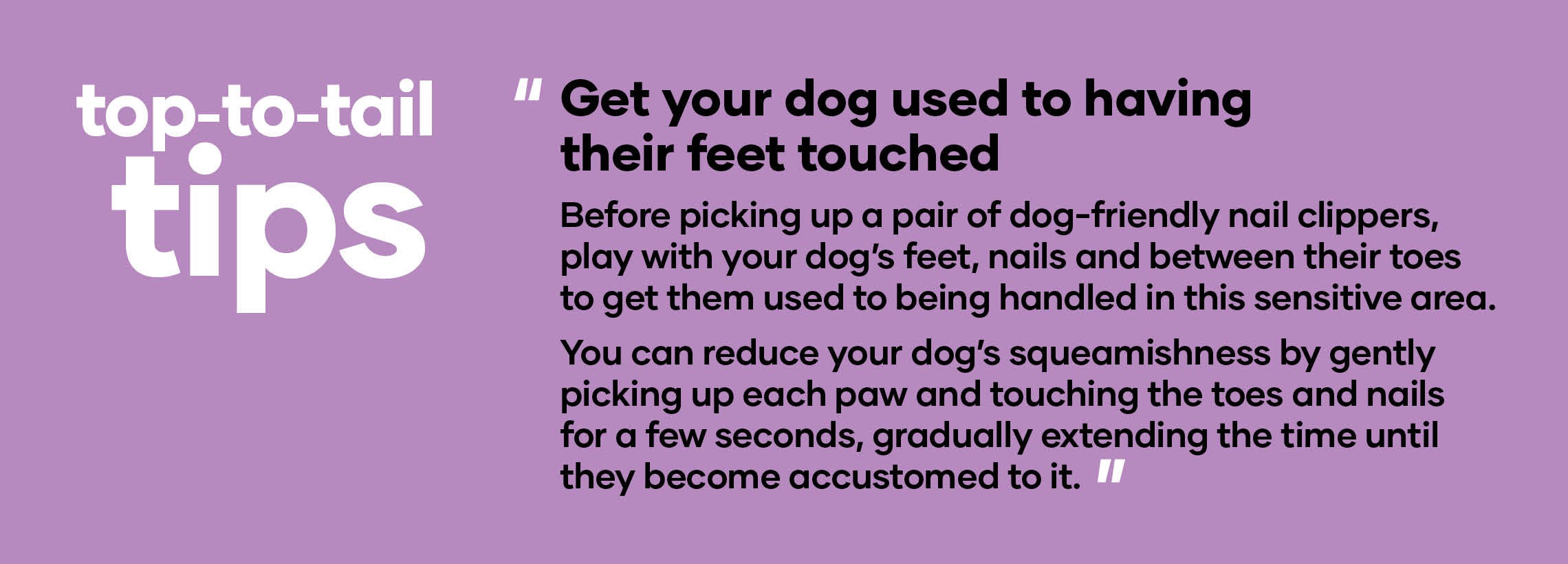
Make sure to always use dog nail clippers to trim your pet’s nails as these are specially designed to suit the strength and shape of dog toenails, and they often include safety features and cutting guides. If you don’t feel confident cutting your dog’s nails yourself, take them into an Animates Grooming salon where our professional groomers can perform this service for you.

As with most activities, it’s best to introduce your pet to having their teeth brushed when they’re a puppy so they become accustomed to this routine, however it’s still possible for old dogs to learn new dental care best practices!
Start slowly by giving their muzzle a light rub with your finger. Progress to gently touching their teeth and gums so they become used to you interacting with the inside and outside of their mouth. You may want to build on this step over a few days before you actually begin brushing their teeth.
Once you can check your dog’s teeth easily, move to tooth brushing. Using a pet-safe toothpaste, start with using toothpaste on your finger. Progress to a dog toothbrush when your canine friend seems to be ready. Always provide praise for good behaviour and a treat after cleaning their teeth (a dental treat would be best!)
Remember to still book regular dental checkups at your local Animates Vetcare clinic, so your vet can inspect your dog teeth and advise if a professional clean is necessary. In addition to having a home dental care routine, it’s important that your dog sees the dentist at least once a year, just like you!
Taking the time to groom your dog at home in between visits to an Animates Grooming salon will keep them healthy, tidy and clean. To understand which dog grooming products best suit your unique pet, visit your local Animates store where our friendly team members can give you personalised advice for grooming large dogs, small dogs, long-haired dogs, short-haired dogs and more.
Regularly grooming your dog at home is important to keep them healthy and smelling fresh. There are five routine grooming habits that you can do at home to help maintain your pet’s health.
Learn how to groom your dog at home by:
- Regularly brushing their coat
- Washing them
- Cleaning their ears
- Trimming their nails
- Brushing their teeth
Make this an enjoyable experience for your dog by only grooming your dog when they are in a calm and relaxed mood, and maintaining a positive tone throughout. You should introduce a regular grooming and brushing routine to your dog when they’re a young puppy so they’re accustomed to you touching and looking at various parts of their body. Grooming your dog at home also provides familiar movements in preparation for your dog to get used to being professionally groomed in an Animates Grooming salon.

Step one in grooming is brushing your dog. Brushing is important to remove loose fur, dirt and debris from your dog’s coat. This also allows your dog’s skin to breathe and stay healthy, and reduces the amount of fur that is shed on your furniture. It also helps to spread natural oils throughout your dog’s coat to increase its shine, and gives you time to bond with your pet.
How often you should brush your dog’s hair varies by breed, but it’s a great idea to brush your dog at the same time every day. You can also use this time to check your dog’s skin and coat for ticks, lumps, cuts and other skin issues.
Brush your dog’s coat in the direction that it grows and be gentle and patient with any tangles. Sensitive areas that you should focus on are their face, ears, neck ruffs, and any feathering on their legs. Brushing matted dog hair out is also important. If you notice any matted hair in your dog’s coat, try to remove them with a coat conditioner or detangler product. If you’re unable to detangle the mat, we highly recommend that you do not attempt to cut it off with scissors as you may accidentally cut your dog’s skin. Instead, have a professional groomer at an Animates Grooming Salon remove the matting from your dog’s fur.

Depending on your dog’s coat type, there are a variety of dog brushes, combs, rakes and grooming gloves that will best suit their needs. Ask the friendly team members at your local Animates store which combination of grooming products will keep your dog’s coat in the optimum condition. The range includes products suitable for brushing dogs with short hair as well as long hair.

The next step is to wash and bathe your dog, although you will not have to do this every time you groom them. How often you should wash your dog will depend on factors such as their coat, environment, and activity. Ask your local Animates Vetcare team for a recommendation on how often your canine companion needs to be washed at home. As a rough guide, most dogs will not need to be washed more than once a month, though exceptions can be made for when your playful pet jumps into a puddle of mud! Don’t wash your dog more than necessary or you may risk stripping the natural oils from their coat and cause it to dry out, especially if you’re using a harsh soap-based shampoo.
Before washing your dog at home, brush through their coat to remove any tangles, and gently place cotton balls in their ears to prevent water from getting in. Where to wash your dog varies depending on your situation, but a bathroom with a tub or sink can work. Fill a tub with lukewarm water and make sure that you provide your dog with a non-slip mat to stand on. If you have a large dog that cannot fit into a tub or sink, Animates’ DIY Dog Wash units are conveniently located at our stores for a safe and mess-free way to bathe your dog.
Always use dog shampoo and conditioner and not human products, to wash your dog. Gently lather your dog with the appropriate dog shampoo, taking care to keep the shampoo out of their eyes and ears. Be sure to thoroughly rinse the shampoo from your dog’s coat as it can irritate their skin if left in. Leave in or wash out conditioner depending on what product you’re using. Finally, use a towel to help your dog dry off, and let them air dry the rest. They will want to shake, so be careful where you wash your dogs. Indoors may not be totally appropriate! You can use a hair dryer on a cool setting and low fan speed to ensure their coat is dry and fluffy.

It is possible for you to clean your dog’s ears at home but it’s best that you have a professional groomer or vet show you how to do it first. Ear cleaning is not without potential complications so an understanding on how to do it properly is important. Did you know Animates Grooming Salons offer a dog ear cleaning service that you can take advantage of?
Only specially designed dog ear cleaners should be used in your dog’s ears. Drip this solution into your pet’s ear and gently massage to help break down the wax and debris. After about 20 seconds, you can carefully and gently use a clean tissue (not cotton tip) to clean away the debris. Then, repeat this process on the other ear.
Your local Animates Vetcare team can recommend how often you’ll need to clean your dog’s ears depending on elements including their breed. Dogs with long ears with a lot of hair may require special attention when cleaning their ears.
Your dog’s ears should never smell, and any odour could be a sign of an ear infection. A possible sign that your dog’s ears are infected and will need to be assessed by an Animates Vetcare Vet is if there’s discharge, if the ears are red and inflamed, or if your dog is shaking their head and scratching at their ears.

How often you have to cut your dog’s nails is influenced by their activity levels. Highly active dogs who have naturally worn their nails down through running on hard surfaces may not need their nails cut, while indoor dogs who only go for a short walk each day will need their nails regularly trimmed.
A dog’s toenails consist of the nail itself which surrounds the quick, the pink part inside which supplies blood to the nail. Be very careful that you do not cut into the quick as it will bleed quite a lot and hurt your dog. For dogs with black nails where you cannot see the quick, it can be more difficult to avoid cutting it but the best method for trimming your dog’s nails is to simply trim the hooked part of the nail that is curving down. For dogs with dewclaws, you must trim these as well as they cannot naturally wear down.

Make sure to always use dog nail clippers to trim your pet’s nails as these are specially designed to suit the strength and shape of dog toenails, and they often include safety features and cutting guides. If you don’t feel confident cutting your dog’s nails yourself, take them into an Animates Grooming salon where our professional groomers can perform this service for you.

As with most activities, it’s best to introduce your pet to having their teeth brushed when they’re a puppy so they become accustomed to this routine, however it’s still possible for old dogs to learn new dental care best practices!
Start slowly by giving their muzzle a light rub with your finger. Progress to gently touching their teeth and gums so they become used to you interacting with the inside and outside of their mouth. You may want to build on this step over a few days before you actually begin brushing their teeth.
Once you can check your dog’s teeth easily, move to tooth brushing. Using a pet-safe toothpaste, start with using toothpaste on your finger. Progress to a dog toothbrush when your canine friend seems to be ready. Always provide praise for good behaviour and a treat after cleaning their teeth (a dental treat would be best!)
Remember to still book regular dental checkups at your local Animates Vetcare clinic, so your vet can inspect your dog teeth and advise if a professional clean is necessary. In addition to having a home dental care routine, it’s important that your dog sees the dentist at least once a year, just like you!
Taking the time to groom your dog at home in between visits to an Animates Grooming salon will keep them healthy, tidy and clean. To understand which dog grooming products best suit your unique pet, visit your local Animates store where our friendly team members can give you personalised advice for grooming large dogs, small dogs, long-haired dogs, short-haired dogs and more.


